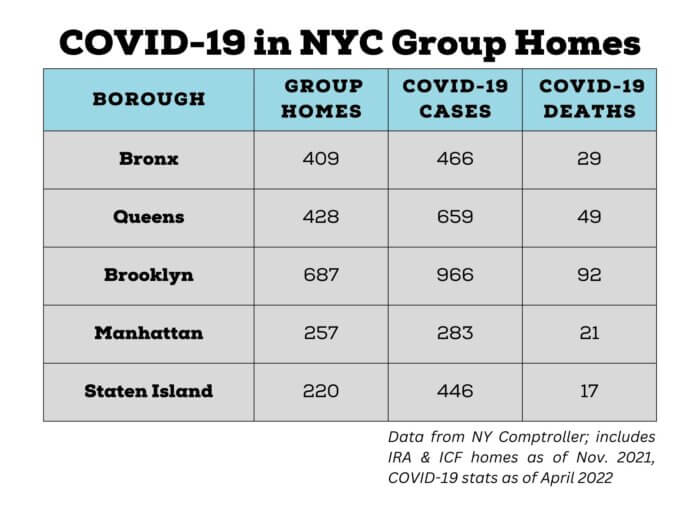Apr. 7, 2023 By Aliya Schneider
A state comptroller audit found that people in group homes during the pandemic were put “at risk” in New York City and throughout the state.
The state comptroller audit, which was released Thursday, found that during the onset of the COVID-19 pandemic in 2020, the emergency management coordination from the state Office for People with Developmental Disabilities (OPWDD) was inadequate. OPWDD is responsible for overseeing all certified group homes in New York, which are either run by the state or by non-profit organizations.
“Group homes are supposed to offer people with developmental disabilities safe places to live as independently as possible,” state Comptroller Thomas DiNapoli said. “Our audit found the Office for People With Developmental Disabilities did not issue timely, consistent guidance to the vast majority of their certified group homes. Inconsistent emergency management coordination and oversight put residents, families and staff in harm’s way.”
People with intellectual and developmental disabilities, which OPWDD serves, are more susceptible to infectious diseases like COVID-19 and are at a higher risk for more severe outcomes, according to the comptroller’s report.
The audit timeframe spans from January 2019 to April 2022.
The comptroller’s office found that OPWDD had considered the risk of pandemics in its internal emergency planning documents prior to the start of the COVID-19 pandemic, but did not require group homes to do so. Even though the state agency required that group homes had emergency response plans in order to be certified, facilities across the state didn’t consider the spread of infectious disease in their plans, according to the comptroller’s office. Rather, plans focused on extreme weather, fire and missing persons.
DiNapoli’s audit focused on two main types of group homes in the state: Individualized Residential Alternatives (IRAs), which are homes with no more than 10 residents, and Intermediate Care Facilities (ICFs), which are meant for individuals with disabilities that severely limit their independence. These two types of homes make up the majority of group homes in the state, according to the comptroller’s office. As of Nov. 21, 2021, there were 30,652 clients living in IRA facilities and 3,465 living in an ICF, according to the comptroller’s office.
The audit found that the agency only created COVID-19 response plans for the eight state-run ICF facilities, which only account for less than 1% of group home residents statewide. This left the non-profit run ICFs and all the IRAs in the state, which together total 6,921 homes, to create their own response plans, according to the comptroller’s office.
From March 2020 to April 2022, OPWDD reported that in New York City, there were 2,820 cases and 208 COVID-19 related deaths at IRAs and ICFs. Since the agency reported 12,928 cases and 653 COVID-19 related deaths at these two types of facilities during the same timeframe statewide, the five boroughs saw almost 22% of cases and nearly 32% of deaths. Nearly 29% of IRAs and ICFs in the state are located in NYC.

While Brooklyn had the highest number of COVID-19 cases and deaths at these group homes out of the five boroughs, Staten Island had the highest ratio compared to the number of group homes in the borough.
There were 151 cases and four deaths at other types of group homes in the state during the same time frame — which are excluded from the above analysis — according to data from the comptroller’s office.
While auditors didn’t claim that OPWDD’s shortcomings directly caused COVID-19 cases, the comptroller’s office questioned why the agency didn’t do more to ensure other facilities were better prepared to handle the pandemic. Auditors found that OPWDD was “more reactive than proactive, implementing corrective steps only after the need had been identified.”
As an example, OPWDD started surveying group homes in May 2020 to better assess how they were responding to COVID-19, but investigators from the agency only visited 22% of homes, according to auditors. Auditors also found that the OPWDD investigators’ checklists didn’t always have the most up-to-date guidance, risking homes not being held accountable for following COVID-19 requirements.
The audit also found that 81 homes were shuttered or temporarily closed across the state from March 2020 to November 2021, which OPWDD said was due to staffing shortages. Because of the shortages, some employees “worked days at a time, slept at the home, and worked across different homes to fill staffing gaps,” which taxed the ability for staff to work effectively and increased the risk of COVID-19 transmission, according to the report. Out of 16 homes auditors visited, only nine had emergency staffing plans.
“We cannot forget, the city was the epicenter of the pandemic and group homes were dealing with an unprecedented situation,” Tina Kim, the deputy comptroller of State Government Accountability, said in a statement to the Bronx Times.
In the audit report, OPWDD disputes various elements of the probe, including the focus on emergency planning documents. In a statement to the Bronx Times, OPWDD spokesperson Erin Silk said the agency is proud of its handling of the pandemic.
“During a global pandemic, OPWDD implemented best practices across facilities to minimize infections and satisfy state quarantine and isolation guidance, while keeping those residents in group homes safe and connected with loved ones,” Silk said. “While the ever-changing nature of the public health emergency demanded agility in implementing New York State Department of Health and CDC guidance, OPWDD is proud of the efforts that were made to sustain continuity of services while ensuring health and safety during this unprecedented, worldwide event.”
But according to the comptroller’s office, OPWDD officials were uncooperative with auditors for almost a year, questioning the office’s authority and resisting requests for data.
Reach Aliya Schneider at aschneider@schnepsmedia.com or (718) 260-4597. For more coverage, follow us on Twitter, Facebook and Instagram @bronxtimes